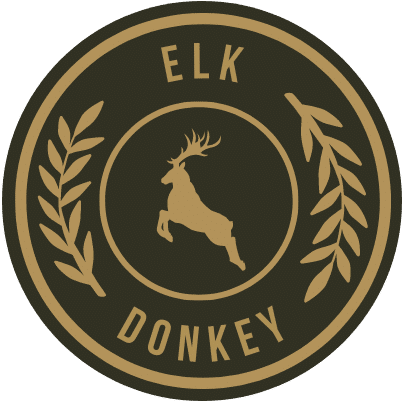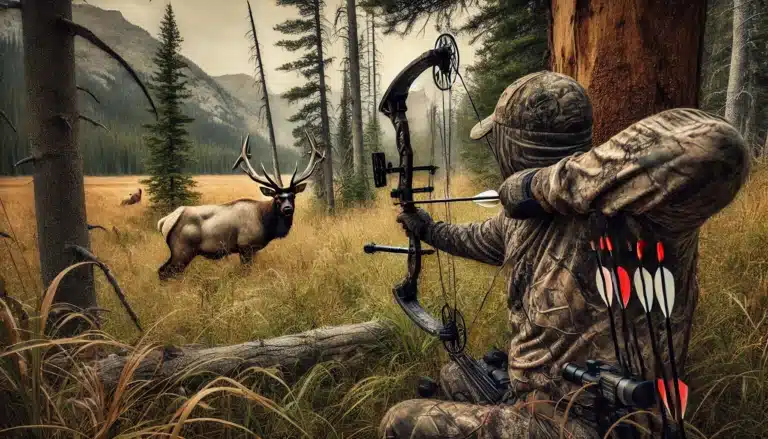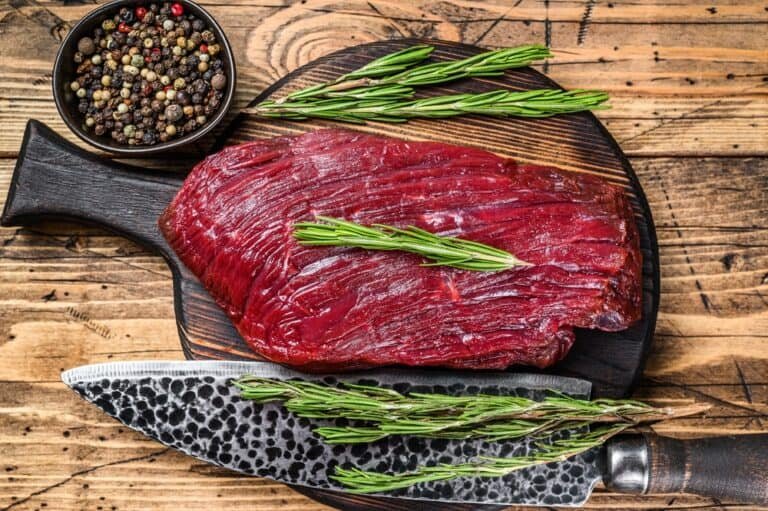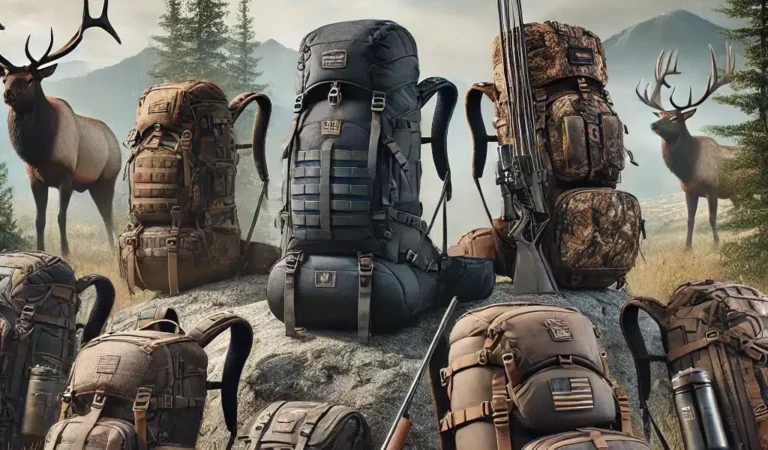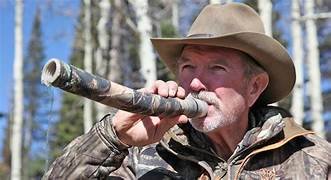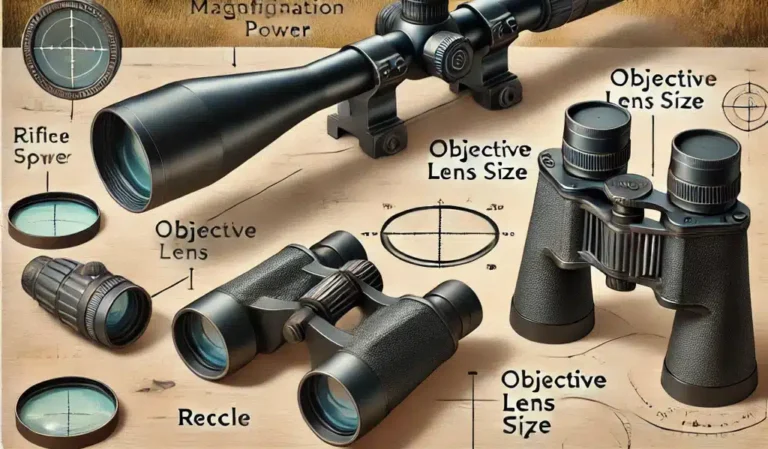7 Best Elk Caliber Options That Guarantee Confidence
The bull elk stood broadside at 300 yards, my crosshairs steady on his vitals. After months of research and practice with different calibers, I knew with absolute certainty that my rifle would do its job. That confidence didn’t come easy – it came from understanding what matters when choosing an elk cartridge. Now I’m going to share with you my findings for the best elk caliber options.
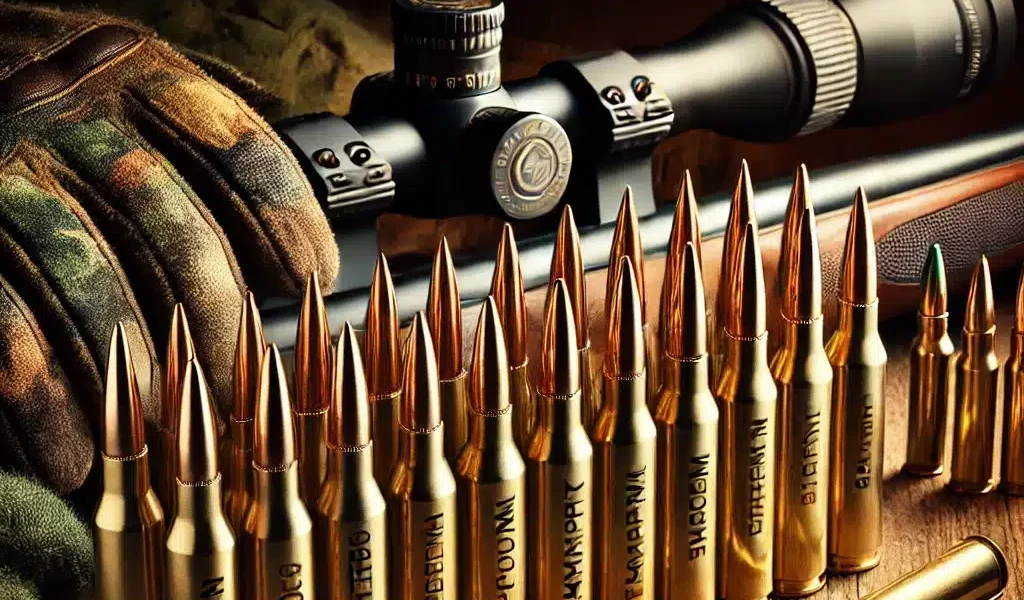
Let’s be honest: choosing the right caliber for elk hunting can feel overwhelming. Walk into any hunting camp and you’ll hear heated debates about the “best elk caliber” that can last longer than the hunt itself.
I’ve spent 15 years guiding elk hunters and seen everything from tiny 6.5s to hand-cannons that could drop a grizzly at a mile. Here’s the truth: while there are many good elk cartridges, some simply perform better than others.
In this guide, we’ll cut through the gun shop gossip and look at what really works in the field. I’ll share the exact calibers I’ve seen put bulls on the ground consistently, backed by real ballistic data and feedback from dozens of successful hunters.
Whether you’re planning your first elk hunt or looking to upgrade your current rifle, you’ll learn:
- Which calibers consistently perform well on elk-sized game
- How to match the right cartridge to your hunting style
- The truth about energy requirements and shot placement
- Real field results from experienced guides and hunters
- Practical factors that matter more than ballistics charts
No complex charts or technical jargon – just straight talk about what works and why. Let’s find the elk caliber that will give you the confidence you need when that trophy bull steps into view.
Understanding What It Takes To Drop An Elk
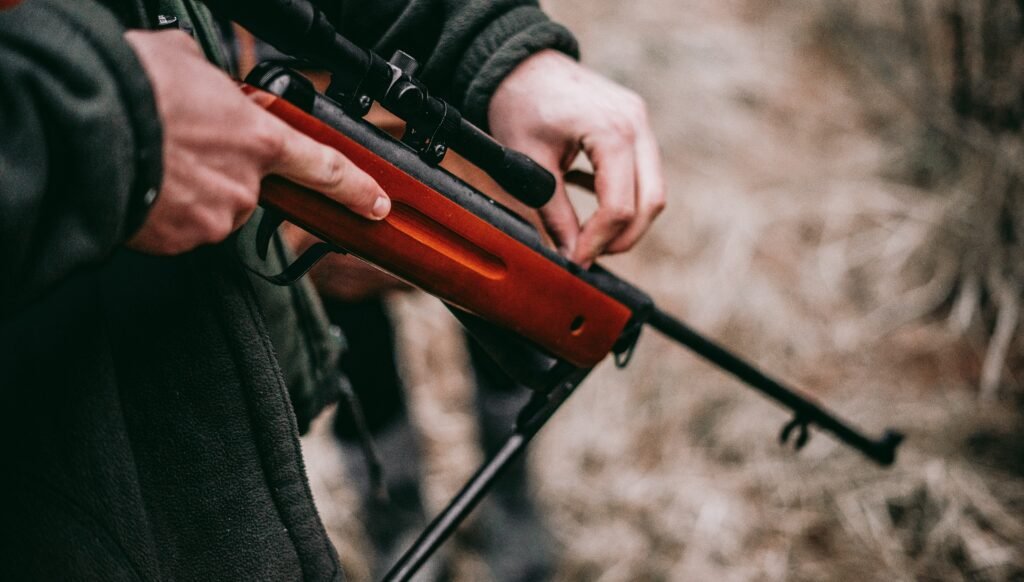
You’re not hunting whitetail anymore. A mature bull elk can weigh over 700 pounds, with thick hide, heavy bones, and dense muscle that would make a defensive linebacker jealous. I’ve seen countless hunters show up out West with their trusty deer rifles, only to learn that elk are a different ball game entirely.
The Hard Truth About Elk Anatomy
Picture this: You’ve got roughly 18 inches of muscle, bone, and tissue to punch through before reaching the vitals. Even a “perfect” broadside shot on an elk requires significantly more bullet performance than most deer hunters expect. Here’s what you’re dealing with:
- Hide thickness: About 3-4 times tougher than whitetail
- Shoulder bone: Nearly twice as thick as a deer‘s
- Vital zone: Larger but more heavily protected
- Muscle mass: Can be 4-6 inches thick on each side
I once watched a hunter put a well-placed shot on a bull using a caliber that was just a bit too light. The bull ran three miles through nasty terrain before we recovered him. That’s exactly the situation we want to avoid.
Real-World Performance Requirements
Let’s cut to the chase – here’s what your elk round needs to deliver:
- Minimum Impact Energy: 1,500 ft-lbs at your expected shooting distance
- Bullet Weight: Generally 165 grains or heavier
- Velocity: At least 2,200 fps at impact for reliable expansion
- Construction: Premium bullets that hold together on heavy bone
But here’s something most articles won’t tell you: these are just starting points. Your hunting situation might demand more.
When Numbers Meet The Mountain
In my years of guiding, I’ve noticed patterns that no ballistics chart will show you:
- Timber hunters rarely shoot past 100 yards: Lighter recoiling calibers can work
- The open country often means 300+ yard shots: Magnum performance becomes valuable
- High-country hunts above 9,000 feet: Bullet performance changes significantly
- Bad weather hunters need heavy bullets: Wind drift becomes critical
“I guided a hunter who insisted his hot-loaded .270 was enough gun for elk. After watching him wound and lose a nice bull despite a solid hit, he switched to a .300 Win Mag the next season. Since then, he’s taken five bulls, none requiring more than a short blood trail.” — from my 2022 guiding season
What Matters Most
Before we dive into specific calibers, remember this: the best elk cartridge is one you can shoot well under field conditions. I’ve seen more elk lost to poor shot placement than marginal calibers. You need to balance:
- Recoil, you can handle it confidently
- Ammunition you can afford to practice with
- A readily available cartridge
- Performance that matches your hunting situation
Pro Tip: Don’t get caught up in the “bigger is better” trap. The ability to place your shot perfectly with a slightly smaller caliber beats spraying and praying with a cannon you’re afraid to shoot.
The Best Elk Calibers: Real-World Performance
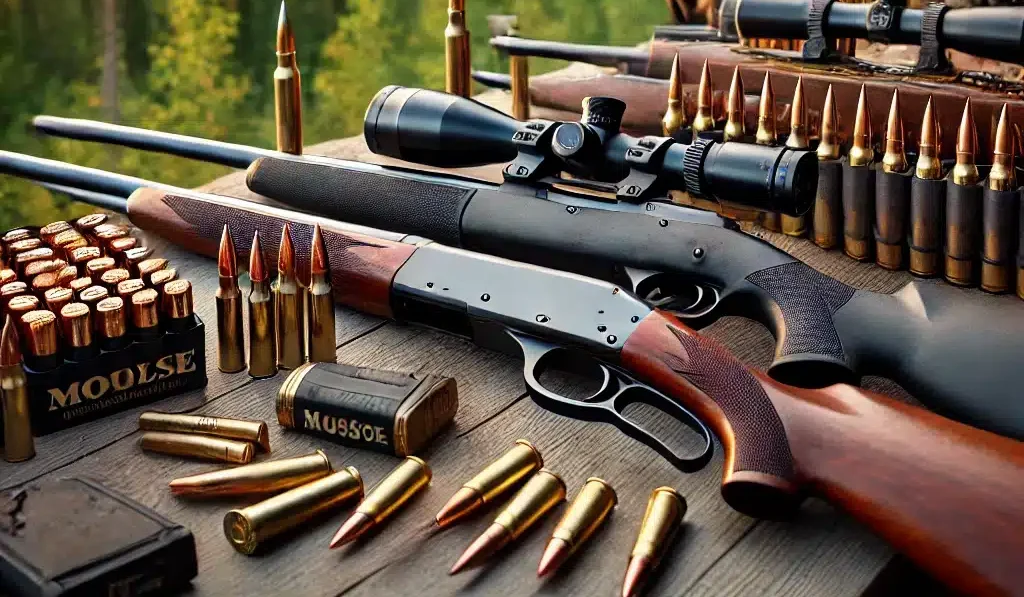
Let’s dive into the calibers that actually perform in the field. I’ve organized these based on thousands of hours guiding elk hunters and countless campfire discussions with experienced guides and hunters. No theoretical ballistics here – just what works when the rubber meets the road.
The Proven Performers
1. .300 Winchester Magnum The All-Around Champion
If I had to pick one do-it-all elk cartridge, this would be it. The .300 Win Mag hits the sweet spot for power, availability, and manageability. Here’s why it works:

Features
- Practical Range: Effective to 500+ yards
- Bullet Weights: 165-200 grains
- Recoil: Stout but manageable
- Real-World Success Rate: Excellent
Field Notes
Using 180-grain premium bullets, I’ve never seen a well-hit elk go more than 100 yards. That’s the kind of performance you can stake your hunt on.
2. 7mm Remington Magnum The Flat-Shooting Friend
Don’t let anyone tell you the 7mm Mag isn’t enough gun. It’s been dropping elk for decades, and with modern bullets, it’s better than ever:

Features
- Practical Range: 400+ yards
- Bullet Weights: 150-175 grains
- Recoil: Moderate
- Real-World Success Rate: Very Good
Personal Experience
One of my clients uses nothing but 160-grain Accubonds in his 7mm Mag. Five elk, five clean kills. Hard to argue with results like that.
3. .30-06 Springfield The Time-Tested Standard
Call it boring, but the ’06 just works. It’s probably put more elk in freezers than any other cartridge:

Features
- Practical Range: 300-350 yards
- Bullet Weights: 165-180 grains
- Recoil: Moderate
- Real-World Success Rate: Very Good
Truth Talk
The .30-06 might not win any long-range contests, but inside 300 yards, it’s all you need. Plus, you can find ammo anywhere. You just might not be able to find the rifle.
4. 6.5 PRC The New Kid on the Block
This newcomer is changing minds about what makes a good elk cartridge:

Features
- Practical Range: 400+ yards
- Bullet Weights: 140-147 grains
- Recoil: Mild to Moderate
- Real-World Success Rate: Good (with proper bullets)
Important Note
Bullet selection is critical here. Stick to tough, heavy-for-caliber options. The 147-grain bullets have impressed me most.
5. .28 Nosler The Long-Range Leader
When distance is a factor, this round shines:

Features
- Practical Range: 500+ yards
- Bullet Weights: 160-175 grains
- Recoil: Stout
- Real-World Success Rate: Excellent
Reality Check
Barrel life isn’t great, and ammo’s expensive. But for pure performance, it’s hard to beat.
6. .338 Winchester Magnum The Insurance Policy
When maximum punch is needed:

Features
- Practical Range: 400+ yards
- Bullet Weights: 200-225 grains
- Recoil: Heavy
- Real-World Success Rate: Excellen
Guide Tip
If you can handle the recoil, this cartridge gives you margin for error no lighter round can match.
7. .300 PRC The Precision Option
The new benchmark for accuracy and power combined:

Features
- Practical Range: 500+ yards
- Bullet Weights: 175-220 grains
- Recoil: Stout
- Real-World Success Rate: Excellent
Field Observation
Seeing more of these every season, especially among hunters who prioritize precision.
Just because these cartridges are capable of long-range performance doesn’t mean you should be taking extreme distance shots at elk. Ethical hunting means getting close enough to make a clean, sure kill.
Making Your Choice
Here’s how I advise my clients to pick:
- Hunting mostly timber? .30-06 or .300 Win Mag
- Open country shots? 7mm Mag or .28 Nosler
- Mixed terrain? .300 Win Mag or 6.5 PRC
- Want maximum insurance? .338 Win Mag
- Prioritize precision? .300 PRC
Best Ammunition Choices For Elk: What Actually Works
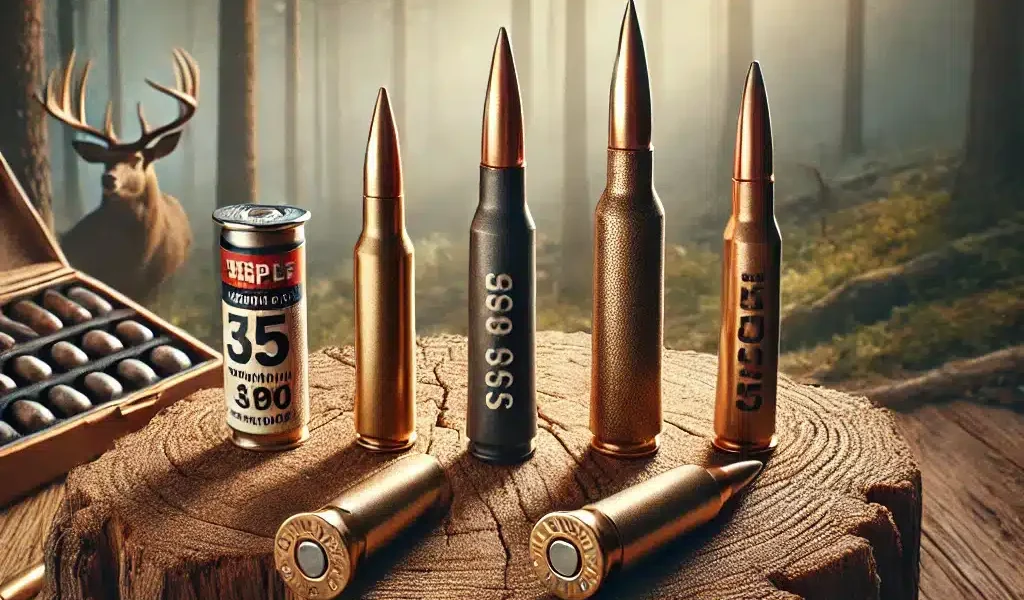
Let’s cut through the marketing hype and look at the specific ammunition that consistently performs on elk. I’ve watched hundreds of elk hit the ground with various loads, and patterns emerge pretty quickly about what works and what doesn’t.
Premium Ammunition Is Worth Every Penny
Look, I get it. When you see premium elk ammo running $70-100 per box, it’s tempting to grab the cheap stuff. But here’s the reality I’ve seen play out:
Good Decision: ✓ Spend $100 on premium ammo ✓ Practice with cheaper rounds ✓ Use premium loads for hunting ✓ One-shot kill ✓ Short blood trail ✓ Full freezer of meat
Bad Decision: ✗ Save $50 on budget ammo ✗ Wounded elk ✗ Long tracking job ✗ Lost meat ✗ Wasted $1000s on your hunt
Top Performing Loads By Caliber
Here are the specific loads I’ve seen perform best in the field:
.300 Winchester Magnum
Nosler 180gr AccuBond
- Best all-around performer
- Consistent expansion
- Excellent weight retention
Hornady 178gr ELD-X
- Great for longer shots
- Deep penetration
- Minimal meat damage
Federal 180gr Termina
- Premium performance
- Works at any range
- Worth the high cost
7mm Remington Magnum
Berger 168gr VLD Hunter
- Devastating terminal performance
- Great for longer shots
- Some hunters report quick kills
Nosler 160gr Partition
- Time-tested reliability
- Perfect balance of penetration and expansion
- Never lets you down
.30-06 Springfield
Federal 180gr Trophy Bonded Tip
- Best balance of penetration and expansion
- Consistent performance
- Available most places
Hornady 178gr ELD-X Precision Hunter
- Modern performance from old faithful
- Great accuracy
- Good terminal effect
“Last season, I watched a client put a 180gr AccuBond through a bull at 340 yards. The elk went maybe 40 steps and tipped over. That’s the kind of performance you’re looking for.”
Load Selection Tips From The Field
Bullet Weight Matters
- Heavier bullets buck wind better
- Better penetration on quartering shots
- More forgiving on less-than-perfect placement
Construction Counts
- Bonded bullets hold together better
- Monolithic bullets penetrate deep
- Premium bullets retain weight
Velocity Sweet Spot
- Too fast can cause premature expansion
- Too slow won’t expand reliably
- Match velocity to your expected range
Warning Signs of Poor Ammunition Choice
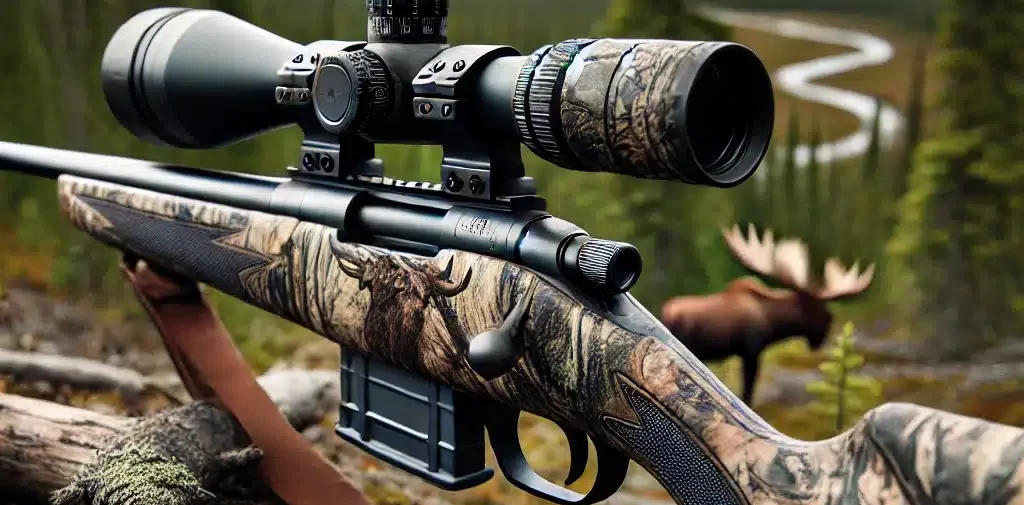
🚫 Avoid these red flags:
- Ultra-light bullets for the caliber
- “Budget” hunting ammunition
- Target/range ammo for hunting
- Unknown brands with big claims
- Ammunition older than 5 years
Practice vs. Hunting Loads
Here’s my recommendation for a practical approach:
For Practice
- Use cheaper ammunition of the same weight
- Focus on shooting fundamentals
- Save premium ammo for final sight-in
Before the Hunt
- Sight in with your hunting ammunition
- Verify zero at different ranges
- Know your drops and holds
Pro Tip: Buy your hunting ammunition a year in advance. Practice with it enough to verify accuracy and zero, then save the rest for hunting season. This helps avoid last-minute scrambles for ammo.
Storage and Care
Keep your hunting ammunition:
- Cool and dry
- In original packaging
- Away from temperature swings
- Marked with purchase date
Building Real Confidence With Your Elk Rifle

I’ve seen too many hunters show up out West with a new magnum rifle they’re afraid to shoot. Let’s fix that with a practical approach to practice that won’t break the bank or bruise your shoulder.
The Truth About Practice
Here’s what separates successful elk hunters from the rest:
- They shoot year-round, not just before season
- They practice realistic positions, not just bench rest
- They know their limits and stick to them
- They’re confident in their gun handling
Reality Check: The time to learn your rifle isn’t when a 6×6 bull steps out at 300 yards. I’ve watched hunters fall apart because they didn’t put in the work before the hunt.”
Your Pre-Season Practice Plan
Month 3-4 Before Season Foundation Building
- 100-yard zero confirmation
- Basic position work
- Focus on fundamentals
- Use practice ammo
- 50-100 rounds
Month 2 Before Season Skill Building
- Field positions
- Distance estimation
- Wind reading
- Mixed practice/hunting ammo
- 40-60 rounds
Month Before Season Confidence Building
- Realistic scenarios
- Cold bore shots
- Hunting ammo only
- 20-30 rounds
Essential Practice Drills
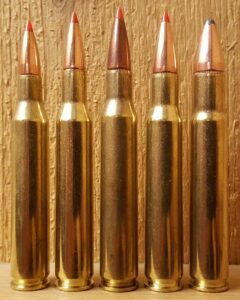



The Cold Bore Drill
- Load one round
- Wait 10 minutes
- Take one shot from field position
- Repeat 5 times
- All hits should be within 2 inches
The Elk Vitals Drill
- 18-inch target
- Random distances (200-400 yards)
- 30 seconds to shoot
- Must hit vitals
- Shoot from various positions
The Wind Call Challenge
- Set up crossing wind
- Estimate wind speed
- Make correction
- Confirm with shot
- Practice in varying conditions
Pro Tip: Use a paper plate as your target. If you can hit a paper plate every time from field positions, you’re ready for elk.
Recoil Management Techniques
Don’t let magnum recoil beat you up:
Proper Fit
- Correct length of pull
- Proper shoulder placement
- Cheek weld position
- Natural point of aim
Gear Solutions
- Quality recoil pad
- Properly fitted scope
- Muzzle brake (if needed)
- Proper shooting jacket
Technique Tips
- Lean into the rifle
- Grip firmly, but don’t death-grip
- Pull straight back into the shoulder
- Follow through after the shot
Distance Estimation Training
Because ranging devices can fail:
Known Distance Practice
- Mark distances at range
- Practice estimating first
- Confirm with rangefinder
- Note common errors
Field Practice
- Range trees/rocks while hiking
- Use truck lengths as a reference
- Practice in varying terrain
- Check yourself often
Building Weather Wisdom
✓ Practice in various conditions:
- Crosswind shots
- Uphill/downhill
- Low light
- Rain/snow if possible
- Different temperatures
When You’re Ready For The Hunt
You should be able to:
- Hit a paper plate at your maximum range
- Get into shooting position quickly
- Handle your rifle confidently
- Know your holdovers
- Make wind calls
- Judge distance reliably
Confidence Checklist: 1. Can shoot 3-shot groups under 2 inches at 100 yards. 2. Comfortable with field positions. 3. Know the exact drops to 400 yards. 4. Can hit the 18-inch target at max range. 5. Confident in wind reading. 6. Rifle maintains zero
Real-World Elk Hunting: Where The Rubber Meets The Road
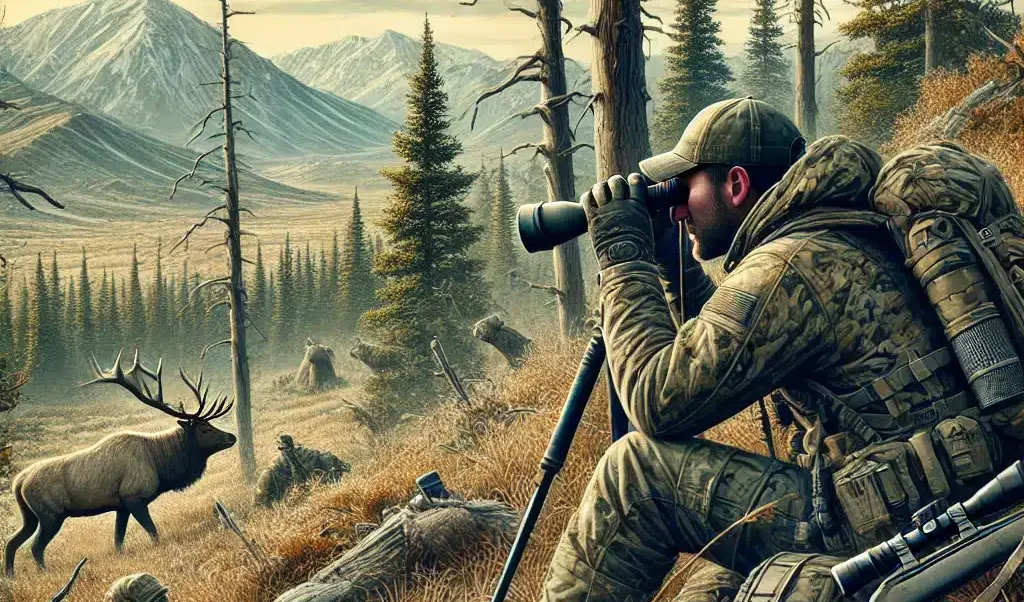
After two decades of elk hunting and guiding, I’ve seen almost every scenario play out. Let’s discuss handling common situations you’ll face in the field with your chosen caliber.
1. The Classic Broadside Shot Most Common in Open Country
✓ Optimal Placement
- Behind the shoulder, 1/3 up from the bottom
- Straight and level
- Wait for the front leg to step forward
- Aim for the opposite side of the shoulder
Pro Tip: Don’t shoot for the shoulder blade. Aim behind it. I’ve recovered too many broken shoulders with unrecovered elk somewhere in the dark timber.
2. The Quartering Away Shot Second Most Common
✓ Adjustment Needed
- Aim slightly farther back
- Angle towards the opposite shoulder
- Requires deeper penetration
- Best for heavier bullets
“Last season, a client took a quartering-away bull at 280 yards with a .300 Win Mag. The 180-grain bullet traveled through 30 inches of elk before stopping under the hide on the far side. That’s exactly what you want to see.”
3. The Steep Angle Shot Common in Mountain Country
✓ Remember
- Aim slightly lower than normal
- True distance is shorter than a straight line
- Hold steady against gravity
- Take your time
Reading Body Language
Learn to read these pre-shot signals:
- Relaxed feeding = good shot opportunity
- Alert head up = wait
- Quartering towards = no shot
- Walking = pick your spot and lead slightly
Environmental Factors

High Country Effects
- Thinner air = less drag
- Bullets impact higher
- Adjust zero accordingly
- Practice at elevation if possible
Wind Reading In Mountains
- Watch grass/trees
- Look for thermal currents
- Multiple wind directions possible
- Consider valley effects
“In high country, your .300 Win Mag might shoot 2 inches higher at 300 yards than at sea level. Verify your zero when you get to hunting elevation.”
Recovery Expectations By Caliber
Magnum Calibers (.300 Win Mag, .338 Win Mag)
- Typical run: 0-100 yards
- Clear blood trails
- Pass-through shots common
- Excellent terminal performance
Standard Calibers (.30-06, 7mm-08)
- Typical run: 50-150 yards
- Good blood trails
- Complete penetration with proper bullets
- Reliable within their range
Lighter Calibers (6.5 PRC, .270 Win)
- Typical run: 100-200 yards
- Blood trails vary
- Shot placement critical
- Bullet selection crucial
Shot Follow-Up Protocol

Immediately After Shot
- Watch the elk’s reaction
- Listen for impact
- Track direction
- Mark your location
- Note landmarks
If Elk Runs
- Watch as long as possible
- Listen for crash
- Mark last seen location
- Stay put for 20-30 minutes
“The biggest mistake I see is hunters rushing after a hit elk. Give them time to bed down and expire. A pressured elk will keep going for miles.”
When Things Go Wrong
If you:
Make a poor hit
- Wait 4-6 hours minimum
- Mark last blood carefully
- Get help if needed
- Grid search likely
Miss completely
- Stay put
- Let area settle
- Try calling
- Be patient
Lose blood trail
- Circle outward
- Look for terrain funnels
- Check water sources
- Consider tracking dog
Success Follow-Up
After a successful shot:
- Take photos quickly
- Begin field dressing promptly
- Cool meat immediately
- Note shot performance
- Save bullet if recovered
Document everything about successful shots: distance, angle, bullet performance, and behavior. This builds a valuable database for future hunts.
Straight Answers To Your Burning Questions
Let’s tackle the most common questions I get from hunters about elk calibers and shooting. No bull, just straight talk from real experience.
Q: “Is my deer rifle enough for elk?”
The most common question I get
A: It depends. Here’s a quick guide:
- .270 Winchester or larger: Yes, with proper bullets
- .243 Winchester or smaller: No, not recommended
- .30-30 or similar: Yes, but keep it under 150 yards
[Experience Note] “I’ve seen .270s drop elk clean, and I’ve seen .300 magnums wound them. It’s more about the bullet and placement than the caliber name.”
Q: “How far is too far for a shot at elk?”
Second most common question
A: Here’s my honest advice:
- New elk hunters: 300 yards max
- Experienced hunters: 400 yards max
- Expert shooters: Whatever range you can hit a paper plate 100% of time
[Real Talk Box] “Just because your rifle can shoot 800 yards doesn’t mean you should take that shot at a living animal. I’ve never lost an elk because I passed on a long shot.”
Q: “Do I really need premium ammunition?”
Asked by every hunter watching their budget
A: Yes, for hunting loads. Here’s why:
- Better penetration
- More reliable expansion
- Better weight retention
- More consistent accuracy
Cost comparison:
- Premium ammo: $70/box
- Lost elk: Priceless
Common Myths Busted
Myth 1: “Bigger is Always Better”
Reality: The best caliber is what you shoot well. Period.
- Proper bullet placement beats magnum power
- Heavy recoil causes flinching
- Practice matters more than power
Myth 2: “Magnums Are Required”
Reality: Standard calibers kill elk just fine.
- .30-06 has taken countless elk
- Shot placement trumps velocity
- Premium bullets matter more
Myth 3: “Lead-Free Bullets Don’t Work”
Reality: Modern copper bullets are excellent.
- Deep penetration
- Reliable expansion
- Less meat damage
- Great weight retention
Common Mistakes To Avoid
Over-Gunning Yourself
- Getting too much recoil
- Not practicing enough
- Developing flinch
- Missing easy shots
Under-Gunning the Hunt
- Too light a bullet
- Wrong bullet construction
- Insufficient energy
- Poor terminal performance
Equipment Over Practice
- Buying expensive gear
- Skipping range time
- Not knowing limitations
- False confidence
Quick Reference Guide
Beginner Elk Hunter
- Recommended: .30-06, 7mm Rem Mag
- Focus: Shooting fundamentals
- Max range: 300 yards
- Priority: Practice over power
Intermediate Hunter
- Recommended: .300 Win Mag, 7mm Rem Mag
- Focus: Shot placement
- Max range: 400 yards
- Priority: Versatility
Advanced Hunter
- Recommended: Any proper elk caliber
- Focus: Precision
- Max range: Proven ability
- Priority: Consistency
[Pro Tip] “The best caliber for elk is the one you can shoot accurately when you’re tired, cold, and excited. Everything else is just details.”
Final Thoughts on Caliber Selection
Remember:
- Shot placement is king
- Premium bullets matter
- Practice trumps power
- Know your limits
- Confidence comes from competence
[Closing Box] “After guiding hundreds of elk hunters, I can tell you this: success comes from the hunter, not the rifle. Pick a caliber you can shoot well, practice until you’re confident, and stay within your limits. That’s the recipe for filled tags.”
